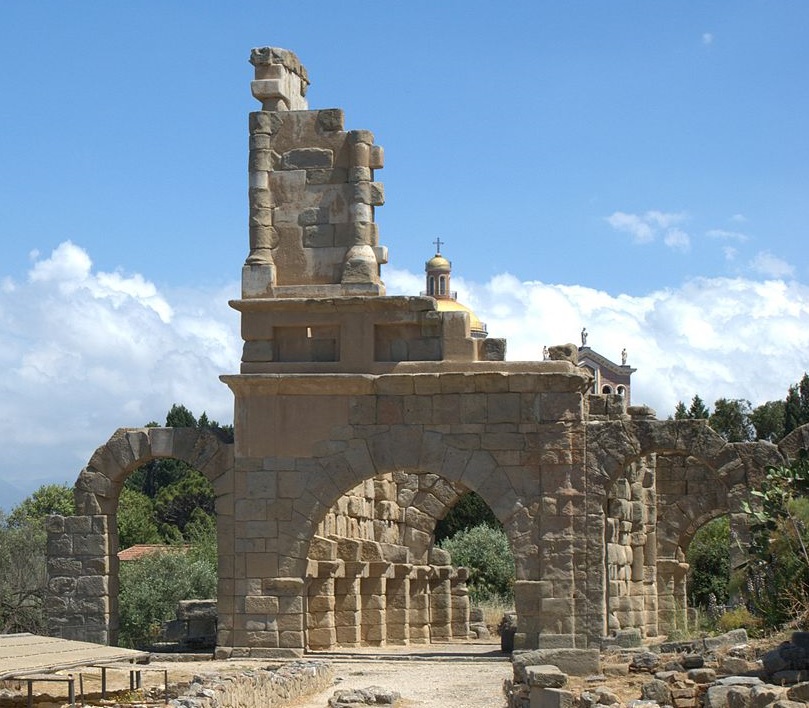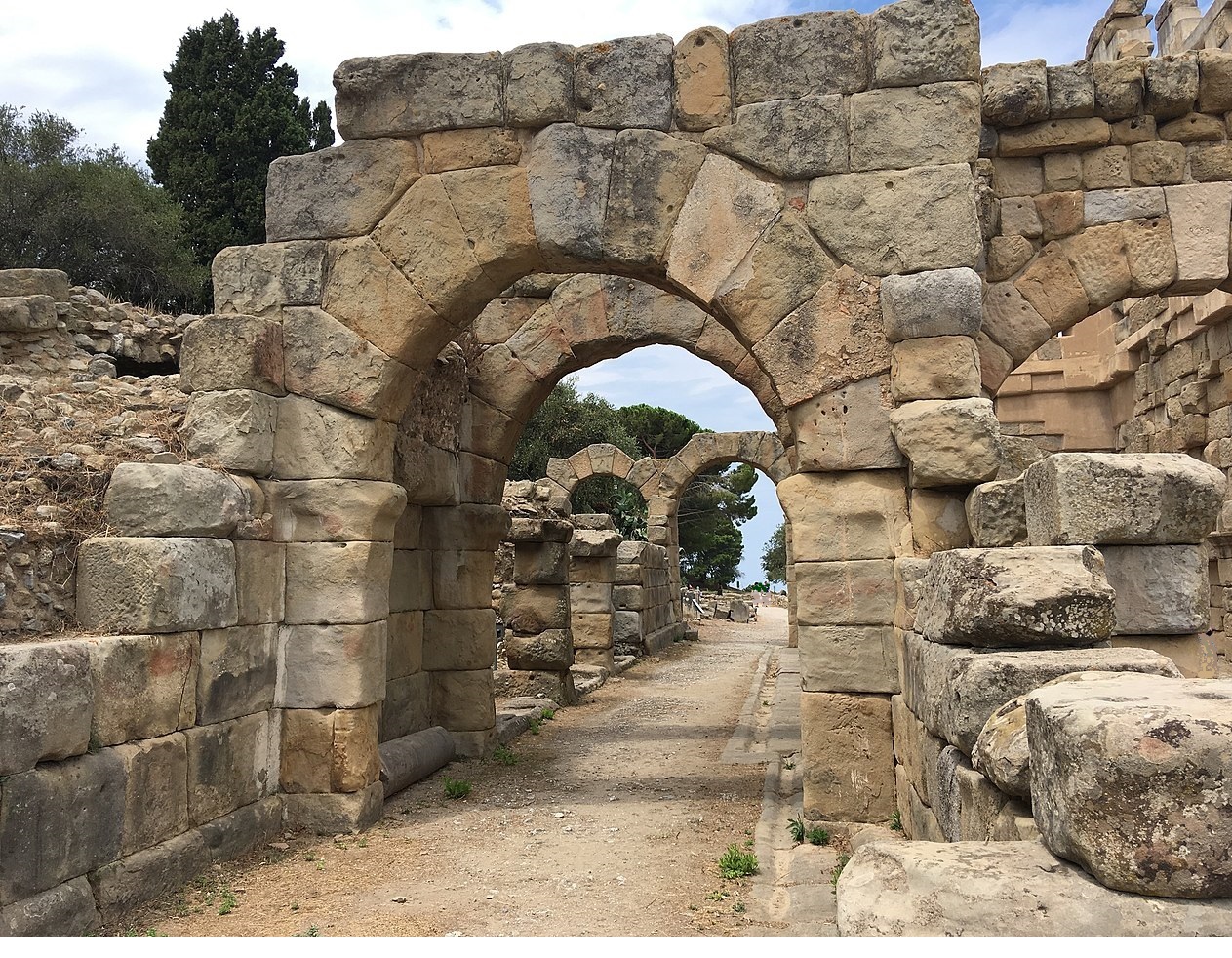PARCO ARCHEOLOGICO DI TINDARI


L'antica città di Tyndaris fu fondata nel 396 a.C. dal tiranno di Siracusa, Dionisio I, sul promontorio omonimo che si estende tra il Golfo di Patti e le Isole Eolie, a scopo difensivo, I primi abitanti erano Messeni, inizialmente in numero di 600 ma che, col tempo, arrivarono a contare un numero di 5000 individui. Il territorio circostante era sotto il dominio della città di Abakainon e nel 393 a.C. Magone vi inviò delle truppe che, però, si scontrarono con quelle di Dionisio I, i quali vinsero. Nel 345 a.C. affiancò Timoleonte nella sua lotta contro Siracusa. Intorno al IV sec. a.C. si costruirono mura difensive in arenaria, rinforzate nel secolo successivo, e ciò fa pensare ad un suo ruolo militare, supportato dalla posizione strategica.
Nel 269 a.C. Tyndaris era occupata dai Mamertini, liberata da Ierone II, e sua alleata durante la prima guerra punica. Ma i Cartaginesi che vi si erano insediati, sospettando un tradimento in favore dei romani, presero in ostaggio i personaggi più eminenti della città e li deportarono nel Lilibeo. La città fu saccheggiata e privata della statua del dio Hermes. Nel 254 a.C. essa passò ai romani, divenendo civitas decumana. Nel 146 a.C., durante la 3^ guerra punica, i tindaritani affiancano Scipione l'Africano, che, per ciò, restituì a Tyndaris la statua sottratta del dio Hermes. Verre perpetrò ai danni della città i più efferati delitti, poiché i tindaritani non volevano consegnargli la statua del dio Hermes, sottopose il protagora di Tyndaris, Sopatro, a delle torture, per cui alla fine i suoi concittadini furono costretti a consegnargliela.
Nel 40 a.C. la città cadde nelle mani di Sesto Pompeo e coinvolta nella lotta contro Ottaviano. Nel 36 a.c. la città venne conquistata da Agrippa, che sconfisse Sesto Pompeo, in una battaglia navale presso le isole Eolie, e quindi venne nominata Colonia Augusta Tyndaritanorum. Ma una catastrofe la colpì, come narrato dallo storico Plinio il vecchio, che descrive di una calamità che danneggiò dimidiam Tyndarida urbem (metà città di Tindari) a causa di un terremoto, la quale venne in parte inghiottita dal mare. Tyndaris continuò, però, ad eccellere, come dimostrano le costruzioni dell'epoca, come quelle del Teatro e della Basilica. Dal V sec. fu sede vescovile. Nel 836 Tyndaris venne occupata, incendiata e distrutta da Fadl Ibn Ya' Qub. L'invasione araba fu deleteria per gli abitanti, i cui superstiti si trasferirono in quella che divenne Patti. Dall'ottocento è iniziata un'attività di ricerca per il sito dell'antica Tyndaris. Intorno agli anni '50 del XX sec. oltre agli scavi, sono state condotte opere di restauro su alcuni monumenti. Evidenziale le possenti mura difensive, la porta principale della città, a dipylon con invito a tenaglia semicircolare, fiancheggiata a due torri ai lati dell’ingresso; le antiche strade (decumani) intersecate da vie più strette (cardines) attraversate da fognature, che delimitano gli isolati (insulae). Il decumano principale è carrabile e pavimentato con blocchi in arenaria. Rilevati alcuni edifici più importanti, come la Basilica, un grande edificio che fungeva probabilmente da propylon (passaggio monumentale) verso la piazza dell'agorà (o foro). Nelle insulae riscontrate delle abitazioni con pavimento a mosaico policromo e le Terme, pavimentate in bianco e nero, con figure diverse. Superate le insuale si arriva al Teatro, risalente tra il IV e il III sec. a.C., suddiviso in 11 cunei di 28 gradini, riadattato in epoca romana per i giochi circensi. Di fronte era l'agorà con una grande cisterna. Nell'estremità occidentale dello scavo trovasi la Domus, con vari ambienti tra cui spicca il triclinium (sala da pranzo), quindi si evidenzia un grande edificio pubblico, il propylon, ed, infine, i resti di un monumento funerario.
Sono stati rinvenuti: un frammento della statua marmorea di Nike (conservata al museo di Siracusa, una statua di Zeus (museo di Palermo), una colossate testa di Augusto, conservata unitamente alle statue di alcuni "Togati" e altri oggetti conservati nell'Antiquarium costruito a ridosso degli scavi.
Per informazioni: https://aditusculture.com/biglietti/sicilia/tindari/parco-archeologico-di-tindari
ARCHAELOGICAL PARK OF TINDARI
The ancient city of Tyndaris was founded in 396 B.C. by the tyrant of Syracuse, Dionysius I, on the promontory of the same name stretching between the Gulf of Patti and the Aeolian Islands, for defensive purposes, The first inhabitants were Messenians, initially they were 600 but who, in time, they arrived to 5000 individuals. The surrounding territory was under the rule of the city of Abakainon, and in 393 B.C. Magon sent troops there, but they clashed with those of Dionysius I, who won. In 345 BC he flanked Timoleon in his struggle against Syracuse. Around the 4th century BC defensive sandstone walls were built, reinforced in the following century, this suggesting its military role, supported by its strategic location
In 269 BC. Tyndaris was occupied by the Mamertines, liberated by Hieron II, and allied with him during the First Punic War. But the Carthaginians who had settled there, suspecting treason in favor of the Romans, took the city's most eminent people as hostages and deported them to Lilybaeum. The city was sacked and deprived of the statue of the god Hermes. In 254 BC it passed to the Romans, becoming civitas decumana. In 146 BC, during the 3rd Punic War, the inhabitats of Tyndaris flanked Scipio Africanus, who, for that, returned the stolen statue of the god Hermes to Tyndaris. Verre perpetrated the most heinous crimes against the city, because the Tindaris citizens did not want to hand over the statue of the god Hermes to him, thus he subjected the protagoras of Tyndaris, Sopatro, to torture, till in the end his fellow citizens were forced to hand it over to him.
In 40 B.C. the city fell to Sextus Pompeius and was involved in the fight against Octavian. In 36 B.C. the city was conquered by Agrippa, who defeated Sextus Pompey, in a naval battle near the Aeolian Islands, and then was named Colonia Augusta Tyndaritanorum. But a catastrophe struck her, as narrated by the historian Pliny the Elder, who describes a calamity that damaged Tyndarida urbem (half city of Tindari) because of an earthquake, which was partly swallowed by the sea. Tyndaris continued, however, to excel, as demonstrated by the buildings of the time, such as those of the Theatre and the Basilica. From the fifth century it was an episcopal see.
In 836 Tyndaris was occupied, burned and destroyed by Fadl Ibn Ya' Qub. The Arab invasion was detrimental to the inhabitants, whose survivors moved to what became Patti. Beginning in the 19th century, the search for the site of ancient Tyndaris began. Around the 1950s, in addition to excavations, restoration work was conducted on some monuments. Evident are the mighty defensive walls; the main city gate, dipylon with semicircular pincer invitation, flanked by two towers on either side of the entrance; the ancient streets (decumani) intersected by narrower streets (cardines) crossed by sewers, delimiting the blocks (insulae). The main decumanus is vehicular and paved with sandstone blocks. A number of more important buildings have been identified, such as the Basilica, a large building that probably served as a propylon (monumental passageway) to the square of the agora (or forum).
In the insulae found dwellings with polychrome mosaic floors and the Baths, paved in black and white with different figures. Past the insulae is the Theater, dating from between the 4th and 3rd centuries BC, divided into 11 wedges of 28 steps, repurposed in Roman times for circus games. Opposite was the agora with a large cistern. At the western end of the excavation was the Domus, with various rooms among which the triclinium (dining room) stands out, then a large public building, the propylon, and, finally, the remains of a funerary monument. The following were found: a fragment of the marble statue of Nike (preserved at the museum in Syracuse, a statue of Zeus (Palermo museum), a colossal head of Augustus, preserved together with the statues of some "Togati" and other objects preserved in the Antiquarium built close to the excavations.
For informations: https://aditusculture.com/biglietti/sicilia/tindari/parco-archeologico-di-tindari